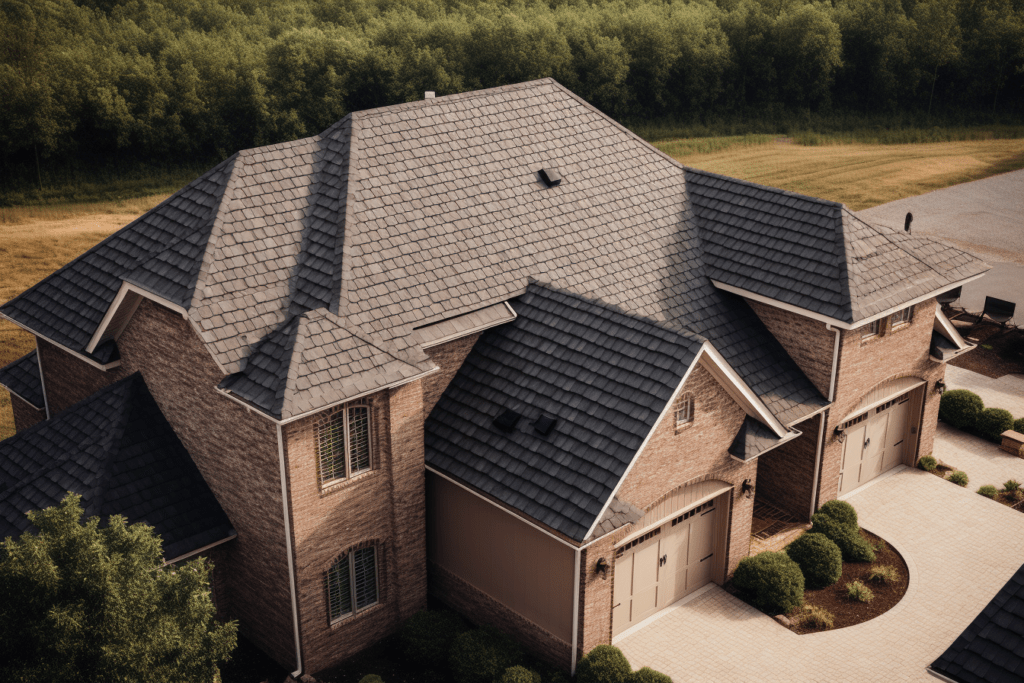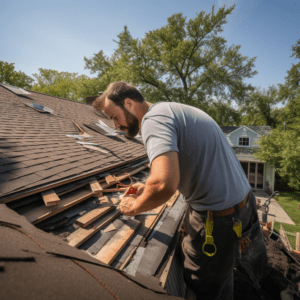Roof installations play a crucial role in the protection and longevity of buildings. According to recent studies, a high-quality roof installation can increase a building’s energy efficiency by up to 30%, resulting in significant cost savings over time. It is imperative to consider key factors such as roofing materials, proper ventilation, and professional installation techniques for long-lasting results. This article aims to provide practical information on choosing the right roofing contractor, avoiding common mistakes during installations, and the importance of regular roof maintenance. Additionally, it explores the understanding of warranties and guarantees for successful roofing projects.
Key Takeaways
- High-quality roof installations provide long-lasting protection against weather elements and maintain the structural integrity of a building.
- Choosing the right roofing materials based on durability and compatibility is crucial for a high-quality roof installation.
- Proper ventilation plays a vital role in roof installations by facilitating the removal of excess heat and moisture, promoting energy efficiency, and preventing damage to the roof structure.
- Selecting a reliable and experienced roofing contractor, considering factors such as credentials, reviews, and industry standards, is essential for a high-quality roof installation.
The Importance of High-Quality Roofing
The significance of high-quality roofing lies in its ability to provide long-lasting protection against weather elements and maintain the structural integrity of a building. A well-installed and properly maintained roof serves as the first line of defense for any structure, shielding it from rain, snow, wind, and other environmental factors. High-quality roofing materials such as asphalt shingles, metal panels, or clay tiles are designed to withstand harsh weather conditions and prevent water leakage.
One key benefit of high-quality roofing is its durability. A sturdy roof can last for several decades with minimal maintenance, reducing the need for frequent repairs or replacements. This not only saves money but also ensures that the building remains structurally sound over time.
Furthermore, high-quality roofing contributes to energy efficiency by providing insulation and reducing heat transfer. Properly insulated roofs help regulate indoor temperature, leading to lower heating and cooling costs throughout the year. This is particularly important in regions with extreme climates where maintaining a comfortable indoor environment can be challenging.
Lastly, high-quality roofing adds value to a property by enhancing its aesthetic appeal and increasing its resale potential. A visually appealing roof gives a positive first impression and improves curb appeal. Potential buyers are more likely to be attracted to properties with well-maintained roofs that offer long-term protection.
Key Factors to Consider for Roof Installations
One important aspect to consider when undertaking roof installations is an evaluation of relevant factors that significantly impact the overall outcome. These factors include the type and condition of the existing roof, structural integrity, weather conditions, material selection, and cost considerations.
Firstly, it is essential to assess the type and condition of the existing roof. Different types of roofs require specific installation techniques and materials. Additionally, evaluating the current state of the roof helps determine if repairs or a complete replacement is necessary.
Secondly, ensuring structural integrity is crucial for successful roof installations. This involves examining the underlying support structures for any signs of damage or weakness. Reinforcements may be needed to ensure long-term stability.
Weather conditions play a vital role in determining when to schedule roof installations. Extreme temperatures or precipitation can affect adhesive properties and compromise installation quality. It is advisable to plan installations during favorable weather conditions for optimal results.
Material selection is another critical factor in achieving high-quality roof installations. The choice of roofing materials should be based on durability, energy efficiency, aesthetic appeal, and compatibility with environmental conditions.
Finally, cost considerations are essential in planning a successful installation project. Evaluating budgetary constraints helps determine whether additional features such as insulation or ventilation systems can be incorporated into the design without compromising quality.
Types of Roofing Materials for Long-Lasting Results
Types of roofing materials play a significant role in ensuring the longevity and durability of roofs. The choice of roofing material is crucial as it determines the ability to withstand environmental factors, provide insulation, and resist wear and tear over time. There are several types of roofing materials available in the market, each with its own unique properties and advantages.
One commonly used type of roofing material is asphalt shingles. These shingles are cost-effective, easy to install, and offer decent durability. They come in a variety of colors and styles to suit different architectural designs. However, asphalt shingles may not be suitable for areas prone to extreme weather conditions such as hurricanes or heavy snowfall.
Another popular option is metal roofing. Metal roofs are known for their exceptional durability and resistance to fire, insects, rotting, and mildew. They can last up to 50 years when properly maintained but tend to be more expensive than other materials.
Clay or concrete tiles are also widely used due to their aesthetic appeal and long-lasting nature. These tiles offer excellent thermal insulation properties and can withstand harsh weather conditions. However, they are heavier than other materials and require proper structural support during installation.
The Role of Proper Ventilation in Roofing Projects
Proper ventilation is essential in roofing projects as it facilitates the removal of excess heat and moisture, preventing damage to the roof structure and promoting energy efficiency. Inadequate ventilation can lead to a build-up of heat and moisture within the roof space, which can cause a range of problems such as mold growth, wood rot, and premature deterioration of roofing materials.
One of the main functions of proper ventilation is to control temperature. During hot weather conditions, an improperly ventilated roof can trap excessive heat in the attic, leading to increased energy costs for cooling the interior space. On the other hand, during cold weather conditions, proper ventilation helps prevent condensation by allowing warm moist air to escape from inside the attic before it comes into contact with cooler surfaces.
In addition to temperature control, proper ventilation also plays a crucial role in moisture management. Excessive moisture buildup in an attic can result in various issues including rusting metal components, degrading insulation properties, and creating an environment conducive to mold growth. By providing adequate airflow through ridge vents or soffit vents combined with exhaust vents on rooftops or gable ends, proper ventilation allows for effective removal of excess moisture from inside the attic space.
Professional Roofing Installation Techniques
Professional roofing installation techniques require careful attention to detail and adherence to industry standards in order to ensure the longevity and durability of the roof. One crucial aspect of professional installation is proper alignment and placement of roofing materials. This includes ensuring that shingles or tiles are correctly positioned, overlapped, and fastened according to manufacturer guidelines. In addition, installers must pay close attention to the alignment of ridge caps, flashings, and other components to create a weather-tight seal.
Another important technique is proper flashing installation. Flashing serves as a protective barrier against water infiltration at vulnerable areas such as chimneys, vents, skylights, and roof valleys. It should be installed with precision and care to prevent leaks from occurring over time.
Furthermore, professional installers must utilize appropriate underlayment materials that provide an additional layer of protection against moisture intrusion. Common options include synthetic underlayments or asphalt-saturated felts.
Lastly, using correct nail placement is vital for ensuring the stability and integrity of the roof. Nails should be driven fully into the decking material without overdriving or underdriving them. Proper spacing between nails and strict adherence to manufacturer’s recommendations are essential for preventing loose shingles or tiles that could lead to leaks or wind damage.
Tips for Choosing the Right Roofing Contractor
When choosing a roofing contractor, there are several key factors to consider. One of the primary considerations is the balance between experience and price. While it may be tempting to opt for the lowest bid, it is important to weigh this against the contractor’s level of expertise and track record. Additionally, credentials such as licenses, certifications, and insurance coverage should also be carefully evaluated to ensure that the contractor meets industry standards and requirements. Lastly, reading reviews from previous clients can provide valuable insights into the contractor’s reliability, professionalism, and quality of work. By taking these factors into account, homeowners can make an informed decision when selecting a roofing contractor.
Experience Vs. Price
The decision to prioritize experience or price in the context of high-quality roof installations is a complex one with implications for both short-term cost savings and long-term performance. While cost considerations are important, it is crucial to not compromise on the expertise and skills required for a successful roof installation. Experienced roofing contractors possess the necessary knowledge and techniques to ensure proper installation, which can significantly impact the lifespan and durability of the roof. They are familiar with industry best practices, local building codes, and potential challenges that may arise during the installation process. While opting for cheaper alternatives may seem attractive initially, it often leads to subpar workmanship and potential issues down the line. Therefore, it is recommended to strike a balance between price and experience by thoroughly researching contractors, obtaining multiple quotes, and assessing their track record before making a decision.
Credentials and Reviews
Credentials and reviews are important aspects to consider when evaluating roofing contractors for a potential project. Credentials provide evidence of a contractor’s qualifications, such as licenses, certifications, and insurance coverage. These credentials demonstrate that the contractor meets industry standards and has the necessary skills and knowledge to perform high-quality roof installations. It is crucial to verify these credentials with relevant authorities or organizations to ensure their authenticity. Reviews, on the other hand, provide insights into the experiences of previous customers. They can help assess a contractor’s professionalism, reliability, workmanship, and customer service. Reading multiple reviews from different sources is recommended to obtain a comprehensive understanding of a contractor’s reputation. By considering both credentials and reviews, homeowners can make informed decisions when selecting roofing contractors for their projects and increase the chances of receiving satisfactory results.
Common Mistakes to Avoid During Roof Installations
This discussion will focus on common mistakes to avoid during roof installations, specifically improper flashing installation, inadequate ventilation system, and poor shingle alignment. Improper flashing installation can lead to water leakage and damage to the underlying structure of the roof. An inadequate ventilation system can result in moisture buildup, which can cause mold growth and shorten the lifespan of the roof. Lastly, poor shingle alignment not only affects the aesthetic appeal of the roof but also increases the risk of wind damage and leaks. It is important to be aware of these key points in order to ensure a successful and long-lasting roof installation.
Improper Flashing Installation
Improper installation of flashing during roof installations can lead to water infiltration and potential structural damage. Flashing is a crucial component in preventing water penetration at vulnerable areas such as roof valleys, chimneys, skylights, and vents. When flashing is improperly installed or not installed at all, it creates openings that allow water to seep into the underlying layers of the roof system. This can result in moisture damage to the roof structure, including rotting of wood decking and rafters, as well as mold growth. Furthermore, if left unaddressed, water infiltration can compromise the integrity of the entire building’s structure. To ensure proper flashing installation, it is important to follow manufacturer guidelines and industry best practices. This includes using appropriate materials such as galvanized steel or aluminum flashing and ensuring correct overlap and sealing techniques are employed. Regular inspection and maintenance should also be conducted to identify any issues with flashing that may arise over time.
Inadequate Ventilation System
One essential aspect of a well-designed roofing system is an effective ventilation system that ensures proper air circulation within the attic space. Adequate ventilation plays a crucial role in maintaining the overall health and durability of the roof. It helps to prevent moisture buildup, which can lead to mold growth and structural damage. Additionally, proper ventilation helps regulate temperature extremes in the attic, reducing heat transfer to living spaces during hot weather and minimizing condensation during cold weather. There are various types of ventilation systems available, including ridge vents, soffit vents, gable vents, and powered exhaust fans. The choice of system depends on factors such as climate conditions, roof design, and insulation levels. Regular inspection and maintenance of the ventilation system are also important to ensure its optimal functioning and longevity.
Poor Shingle Alignment
Inadequate ventilation systems can contribute to various issues with roof installations. Another common problem in high-quality roof installations is poor shingle alignment. Shingles that are not properly aligned can lead to several complications, such as decreased durability and compromised waterproofing. When the shingles are misaligned, they may not overlap correctly or create gaps between them, leaving the roof vulnerable to water infiltration and wind damage. Additionally, improper shingle alignment can affect the overall aesthetics of the roof, giving it an unappealing appearance. To ensure a well-aligned shingle installation, it is crucial for roofing contractors to carefully follow manufacturer guidelines and industry best practices. This includes using appropriate tools and techniques to align each shingle accurately during installation, minimizing the risk of future problems and maximizing the longevity of the roof system.
The Benefits of Regular Roof Maintenance
Regular roof maintenance offers several advantages, such as prolonging the lifespan of the roof and preventing costly repairs. By conducting regular inspections, homeowners can identify minor issues before they escalate into major problems. These inspections should include a thorough examination of the shingles, flashing, gutters, and other components of the roofing system.
One benefit of regular roof maintenance is that it helps to extend the longevity of the roof. Over time, exposure to harsh weather conditions can cause wear and tear on the roofing materials. Regular maintenance allows for early detection and repair of any damage or deterioration, helping to prevent further degradation and potentially adding years to the life expectancy of the roof.
Another advantage is that regular maintenance can help prevent costly repairs. By addressing small issues promptly, homeowners can avoid more extensive damage that may require expensive repairs or even a full roof replacement. For example, if a loose shingle is left unattended, it may lead to water infiltration and subsequent structural damage.
Furthermore, regular roof maintenance contributes to maintaining energy efficiency within a home. Damaged or poorly maintained roofs can result in air leakage or insulation problems which compromise energy efficiency levels and increase heating or cooling costs.
Understanding Warranty and Guarantees for Roofing Projects
Understanding the terms and conditions of warranty and guarantees is crucial for homeowners when considering roofing projects. A warranty is a written agreement between the homeowner and the roofing contractor, which outlines the responsibilities of both parties in case there are any defects or problems with the roof installation. The warranty typically covers materials and workmanship for a specified period, such as 5, 10, or even 20 years. It is important to carefully read and understand the warranty document to know what is covered and what is not. Guarantees, on the other hand, are promises made by manufacturers regarding their products’ performance or durability. These guarantees may cover specific aspects such as resistance to leaks or fading over time.
Homeowners should pay attention to certain details when reviewing warranties and guarantees. Firstly, they should check if there are any exclusions or limitations that could void the coverage. For instance, some warranties may require regular maintenance checks by certified professionals to remain valid. Secondly, homeowners should understand how claims are processed and what steps need to be followed in case an issue arises. Lastly, it is essential to clarify whether transferability options exist if the property changes ownership.




